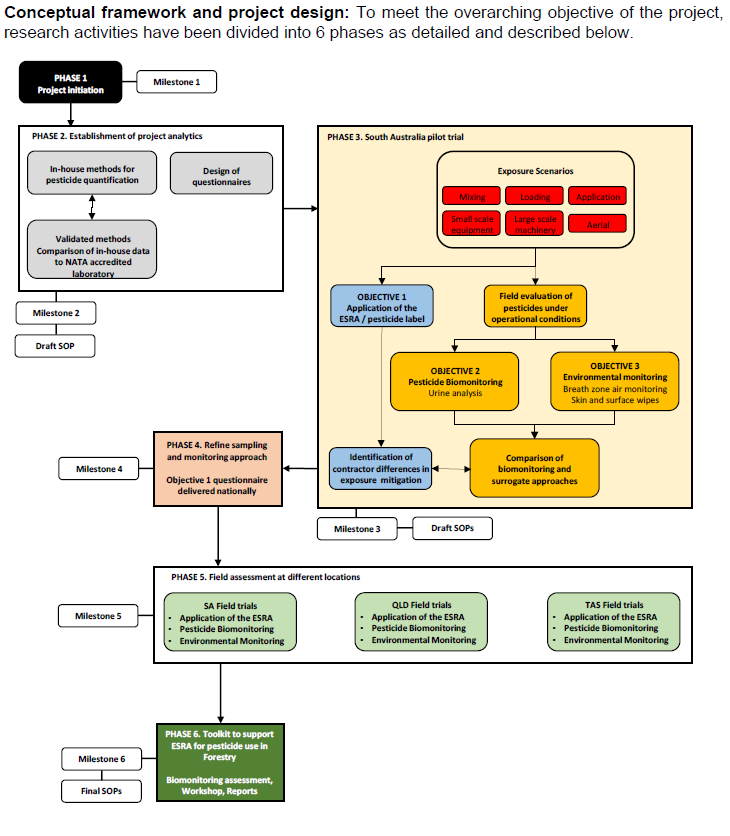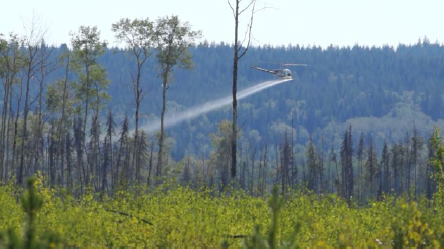Assessment of current best practice techniques for handling pesticides in forestry applications
Lead Researcher: Professor Albert Juhasz
The Project
The objective of this project is to develop a tool kit for monitoring / predicting pesticide exposure to support environmental and social risk assessments for pesticides used in forestry operations.
Industry Partners
UniSA will collaborate on this project with the following industry partners: Australia Forest Products Association, HVP Plantations, HQPlantations, Timberlands Pacific Pty Ltd, PF Olsen Australia (acting as agent for the Forestry Investement Trust), Forico, All Above Reforestation Australia, Australian Forest Contractors Association, C3 Australia Pty Ltd
Our Research Approach
The project will develop a tool kit to monitoring pesticide exposure to support ESRAs for pesticides used in forestry operations. This will be achieved by:
- Collecting, examining and analysing information on how the pesticide label and company ESRA is interpreted and applied. Differences in operating procedures may account for disparities in individual exposures.
- A biomonitoring approach will be adopted to quantify glyphosate exposure under field conditions. As the toxicokinetics of glyphosate is understood, urinary biomonitoring will be undertaken to accurately quantify internal exposure to determine exposure magnitude, exposure differences between task / operator and whether environmental conditions influence exposure outcomes.
- Environmental monitoring (assessment of breath zone air, skin / surface wipes) will also be undertaken as a complementary approach for exposure evaluation to provide valuable information on exposure pathway apportionment.
Expected Outcomes
Expected outcomes are:
- A tool kit, including biomonitoring and environmental monitoring approaches, to quantify pesticide exposure during forestry operations.
- Measurement of glyphosate exposure in forestry employees and contractors, an understanding of factors influencing exposure and an evaluation of the effectiveness of control measure for exposure minimisation.
Significance of these outcomes are:
- Identifies activities that potentially exhibit greater hazard where supplementary risk mitigation strategies can be employed.
- Provides a feedback loop to inform the effectiveness of risk mitigation strategies.
- Evaluates and demonstrates the effectiveness of policy actions and measures taken to reduce exposure.
- Enhances company care to employees and contractors.
- Establishes the Australian Forestry Industry as the world-leader in best management practice for pesticide handling and application.
Conceptual framework and project design:
To meet the overarching objective of the project research activities have been divided into 6 phases as detailed and described below.

Project Deliverables
To ensure world-leading best management practice for pesticide handling and application, this project will deliver a holistic approach for pesticide exposure assessment. By providing accurate data on internal pesticide exposure, this project will deliver a mechanism to support / enhance current best practice techniques for handling pesticides. The deliverables detailed below will enable harmonized exposure information to be generated for glyphosate, although developed assessment approaches will be adaptable to other pesticides of interest. Outputs will use well established scientific data and analysis techniques to provide reports, presentations and training procedures to upskill Forestry personnel.
Project deliverables include:
- A biomonitoring test method for measuring internal pesticide exposure during forestry operations.
- Environmental test methods for predicting pesticide exposure to inform exposure route apportionment.
- Standard operating procedures for pesticide biomonitoring and environmental monitoring to support world-leading best management practice for pesticide handling and application.
- An assessment approach that evaluates the effectiveness of risk mitigation strategies to reduce pesticide exposure to support workplace practice and environmental and social risk assessments.
- A glyphosate biomonitoring database.
- A biomonitoring tool kit workshop detailing its application to future pesticide activities and employee benefits.



